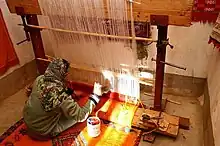The Balai, Balahi, Bhalse or Bunkar are found in the states of Madhya Pradesh, Rajasthan, Punjab, Maharashtra, Delhi and Uttar Pradesh in India.
"Balai" means weaver. [1] Balai weavers are said to be descendants of the Rishi Mrikanda who was born in the clan of Bhrigu Rishi.[2][3]Mrikanda is known as the father of modern weaving, He is also venerated as the father of Markandeya, the rishi (sage) who is featured extensively in the Markandeya Purana.[4]
similar : The Kanjeevaram Silk Weavers are also considered as descendants of Rishi Markanda, who was considered to be the weaver of the clothes that Gods themselves wore. In this way it can be said that all the weaver communities in Hinduism associated with rishi mrikanda too.[2][5]

Weaving is the traditional occupation of Balais.[7]
Bhalse are the sub group from the caste of balai some of the bhalse's are still doing the work of weaving. Bhalse's are bunkars and belong to the vaishya (Bania) caste. They are attached with the work of weaving or selling.[8]
Jain Shravak Sangha had preached among the Balai community in 1964 near Ratlam in village Guradia. Acharya Nanalal Maharaj from Jain Shravak Sangha gave Dharampal Jain Samaj to the balai community in the name of Lord Dharmanath, who was among the Tirthankaras of Jain society. Currently 1.25 lakh people of Malviya and Gujarati Balai community across the country have become Dharampal Jains.[9]
Sometimes balai is also referred as Meghwal.
Beliefs
Balai are Hindus by religion. They are devotees of Maa Durga and Maa Kalaratri.[10] They also pay tribute to Baba Ramdeo Ji and consider "KALRATRI" as their kuldevi.[11] Balais do not marry in their families or within their gotra.[12] They live in multi-caste villages in their own areas and bury their dead.[13]
Balais are traditionally non-vegetarian cause they belief in Bali (animal sacrifice).[11] Animal sacrifice is the part of worshiping Maa Durga and Kalaratri.[12] At present most of the people of the community choose to be pure vegetarian.[14]
Population
According to 2011 Census of India, Rajasthan showed their population as 306,034 contributing 9.11% in state, while there are 2,668,000 in over all country.
Language
They speak languages like Nimadi, Dhundari, Marwadi, Punjabi, Kashmiri and Gujarati in various Indian states.[15]
References
- ↑ Project, Joshua. "Balai (Hindu traditions) in India". joshuaproject.net. Retrieved 23 November 2023.
- 1 2 "Mrekand: The Divine Artisan - Unveiling The Hindu God Of Weaving | The Indosphere". 1 September 2023. Retrieved 26 November 2023.
- ↑ Hinduism, Glorious (2 July 2019). "The Powerful Bhrigu Rishi". Glorious Hinduism. Retrieved 26 November 2023.
- ↑ "Markandeya – Vyasa Mahabharata". Retrieved 26 November 2023.
- ↑ "Everything you need to know about the six-yard wonder Kanjeevaram". Khinkhwab. 26 June 2020. Retrieved 7 December 2023.
- ↑ Bhatt, Hitanshu. "Handloom Communities of India are Keeping Alive the Weaving Legacy!". www.localsamosa.com. Retrieved 26 November 2023.
- ↑ Tilonia®. "Weaving". Tilonia®. Retrieved 7 December 2023.
- ↑ Jacksonville, Florida State College at. "Caste System in Ancient India". Caste System in Ancient India.
- ↑ Gururaghvendra.com (7 May 2023). "जैन धर्म के देवत्व की अवधारणा भाग- प्रथम Jain Dharm ke Devatv Kee Avadharana Bhag Pratham…". Medium. Retrieved 31 December 2023.
- ↑ "Hinduism Basics". Hindu American Foundation. Retrieved 31 December 2023.
- 1 2 "Beliefs of Hinduism (article) | India". Khan Academy. Retrieved 31 December 2023.
- 1 2 "Hinduism Doctrine and Beliefs". Hindu Council of Australia. Retrieved 31 December 2023.
- ↑ Naik, Shambhavi (8 February 2020). "The scientific argument for marrying outside your caste". ThePrint. Retrieved 1 December 2023.
- ↑ Center, Pew Research (29 June 2021). "7. Religious practices". Pew Research Center's Religion & Public Life Project. Retrieved 1 December 2023.
- ↑ "Regional Languages | Legislative Department | India". Retrieved 28 November 2023.